Photos Of Animals Rescued In Ukraine War
The Russian invasion of Ukraine has taken a huge toll on Ukrainians. Millions have been forced from their homes, and tens of thousands have been killed. Cities and towns are destroyed beyond recognition. And as the people of Ukraine and the world try to make sense of a senseless war, some victims cannot do so. Wildlife, farm animals and house pets, unable to evacuate from nonstop barrages of Russian artillery, are also caught up in the conflict that is tearing apart everything familiar around them — be it forest, farm or house.
A massive effort to rescue animals materialized as the war started and became a horrifying part of life in Ukraine. Thousands of animal rights activists, volunteers and other people found themselves in a position to lend a helping hand. Just as they did at the start of the war on Feb. 24, 2022, they wake up every day with a single mission — to save another innocent being.
Asia Sepinska, 77, sits in the kitchen that doubles as her office surrounded by several dogs. Dogs are everywhere; there is a German shepherd napping on a chair across from her; others run in and out of the kitchen into a large space that used to be a dairy farm that now hosts cats, chickens and other animals. Some try to sit on her lap or at least put their heads on her knees.
This year, her shelter celebrated its 22nd birthday. It all started with Sepinska’s visit to a government-run shelter in Borodyanka in 1999. The conditions there were so abhorrent and inhumane that they made a lasting impact on her.
“It was absolutely terrible,” she said. Dogs were standing in mud mixed with their own excrement and snow. They weren’t fed. They were not being looked after. She recalled that the workers at the Borodyanka shelter didn’t seem to care for animals at all. Dogs were eating each other, killing each other — it seemed to her that they were brought there to die, and in the most horrific way imaginable.
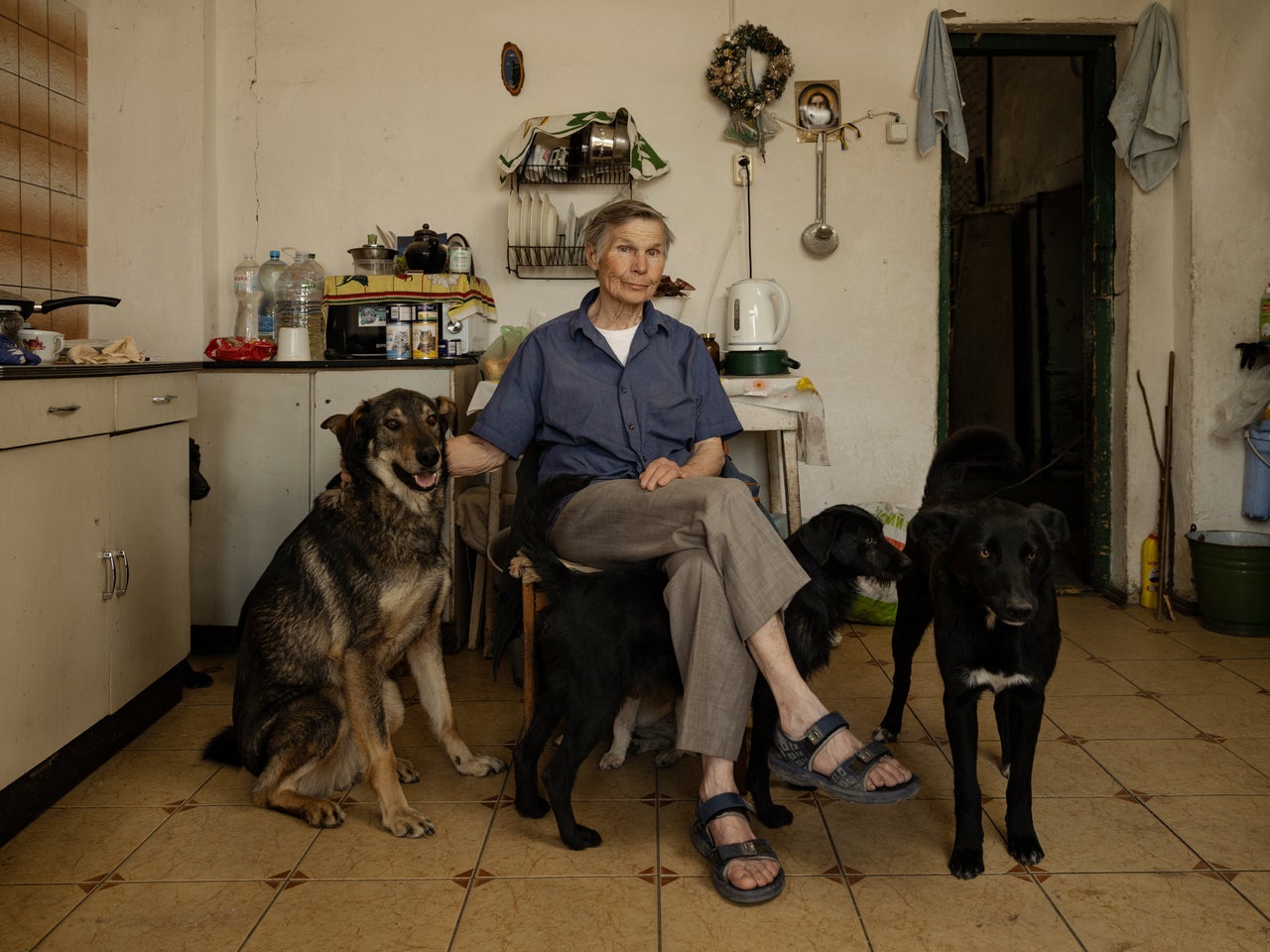
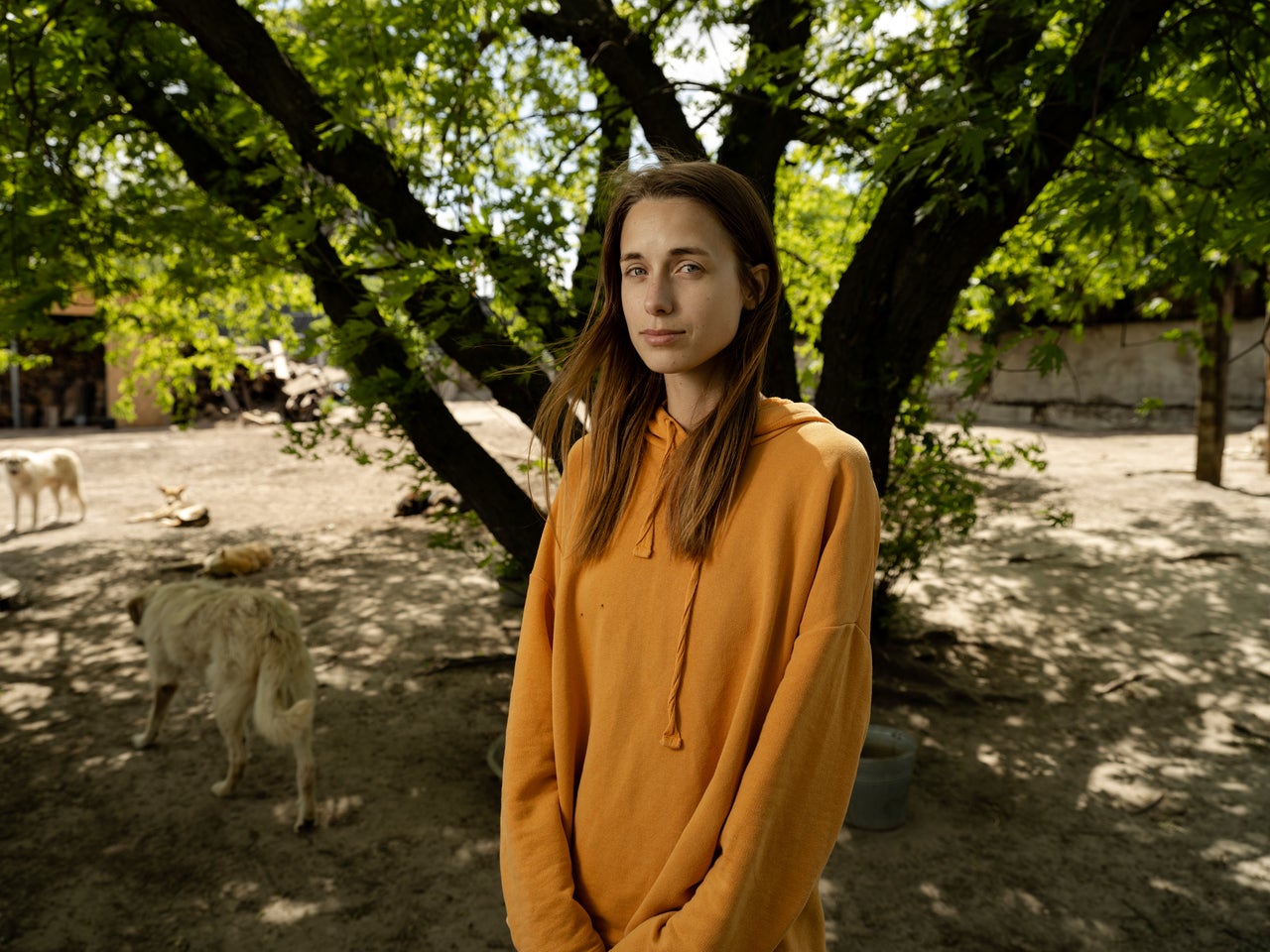
In May 2000, Sepinska opened the doors to her own shelter, hoping to provide ethical treatment and a loving home to all the street dogs she could find. She has managed to keep her shelter open since then. Her granddaughter, Maria Vronska, 24, now helps run it. They manage to support the operations with grants, individual donors and support from the city of Kyiv. Before the full-scale Russian invasion began last February, the shelter was taking care of about 870 dogs.
The city of Hostomel, just northwest of Kyiv, saw some of the war’s fiercest fighting, and the shelter wasn’t spared from the shelling. More than a hundred dogs ran away or were killed by shrapnel. A few projectiles landed right on the property, damaging buildings and fences and killing animals.
On the morning of Feb. 24, Sepinska rushed from Kyiv to Hostomel, worrying not about what could happen to her but to the animals under her care. As people rushed in the opposite direction, she traveled against traffic to make it back to her shelter. Miraculously, she was able to catch a ride to Irpin and then to Hostomel as the active fighting on the outskirts of Kyiv started. The following day, the Russians controlled the area.
The Russian National Guard set up camp right next to Sepinska’s property line, and the day after, on Feb. 26, the Russians were heavily shelled by Ukrainian artillery. Her property didn’t have a bomb shelter of any kind, or even a basement. All the remaining shelter workers could do was hide inside the massive farm building and hope for the best. The shelling continued for another five weeks.
The electricity was cut off, and the shelter’s water pump stopped running. They had no heat, electricity or water for the entire Russian occupation, which lasted a month and a week. Everyone had to stay put to avoid being killed by Russian soldiers.
“People were shot at for just walking on the street,” Sepinska recalled. “We had a body laying outside of the gates for five weeks, and nobody picked him up.”
For water, they melted ice, collected snow and prayed for rain. “We didn’t stop our work for one day,” she said.
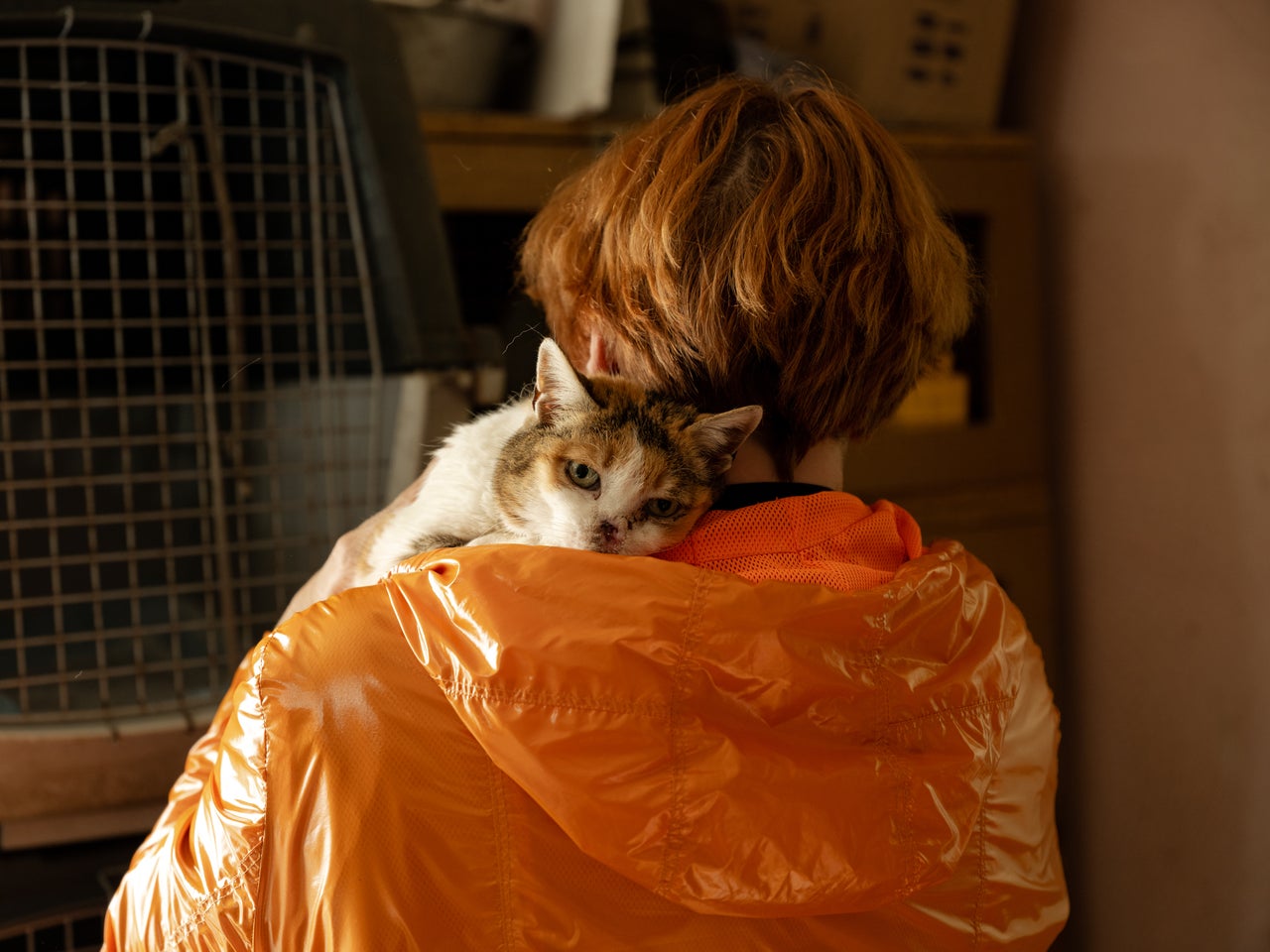
On March 30, Russian soldiers stormed the shelter. They suspected that Sepinska and her team had been feeding the Ukrainian armed forces information about Russian units in the area. There were four people living on the premises, and the Russians found a hidden cell phone. After locking the three women in a back room, they took the only man with them, giving him a beating in front of everyone.
The next morning, he was back. Bruised and tortured, but alive. The Russians retreated that day and left Hostomel. When Sepinska saw Ukrainian troops entering town on the following day, she broke down in tears.
Now Sepinska’s shelter has over 600 dogs and about a hundred cats, many of them saved from abandoned apartments and the streets after the occupation was over. But not all pets could be saved, and the survivors still have a tough life ahead of them as it gets harder to find people who want to take older and injured dogs — Sepinska’s specialty.
Traumatized and often injured, animals that were abandoned or ran away often need much greater care. Maryna Shumeiko, 46, has been caring for pets like this since the first day of the war.
Shumeiko is one of the founders of an animal shelter with the unassuming name CatDog in Ivankiv, a town about 50 miles from Kyiv. CatDog operates out of a small building donated by the town and depends on money from the local budget, which is never enough, as well as donations, grants and pure enthusiasm.
Shumeiko is known as a fierce fighter for animal rights and animal sterilization, which often goes against the school of thought about how animals should be treated, particularly in rural Ukraine. During the occupation, people were fearful of venturing beyond their gates, at risk of getting shot by Russian soldiers. Shumeiko, however, would go to the shelter every day to feed the animals that were already there.
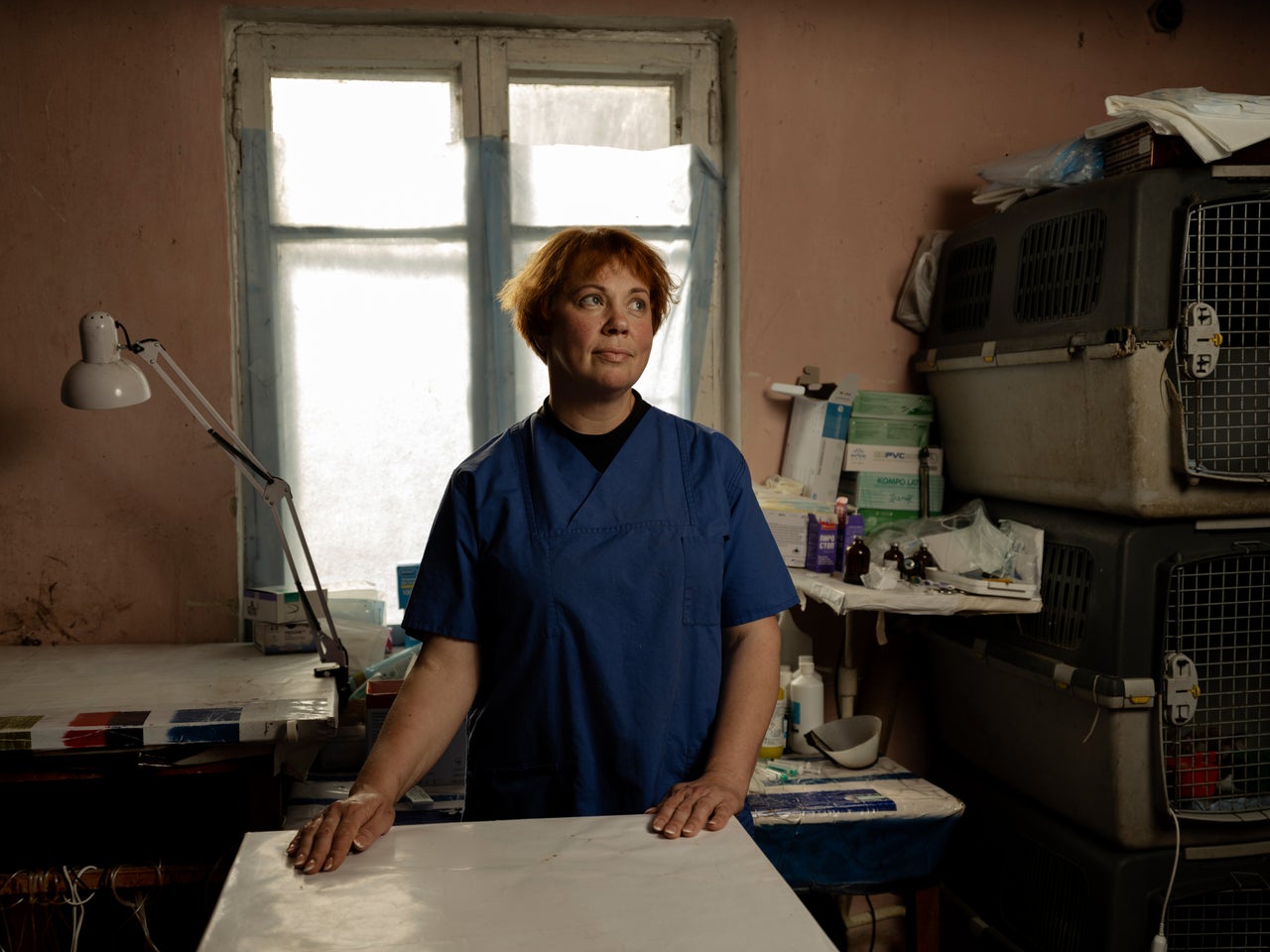
Shumeiko would wait for a quiet moment between the artillery barrages, then hop on her bike and head toward the small red brick house where 17 dogs and 27 cats were waiting for her. “I had a little icon in my backpack, and it protected me,” she said.
Not only has she been taking care of the animals in her shelter and her home, but she also feeds the pets left behind by neighbors who fled. “I went on Facebook and wrote a judgmental post saying that I don’t approve of it but I’ll help you take care of your pets,” she said.
Shumeiko rescued five animals during the occupation that were either abandoned or had run away, probably scared of noises from the bombings, and has been taking care of every living soul she can find. But the work after liberation has been like nothing she’s seen before. People started bringing wounded animals from all around the region. She had to find extra help from a veterinarian in Kyiv who would come and volunteer once a week. She also had to find a new home to accommodate all the animals coming in.
European interest in rescuing Ukrainian pets picked up this year because of the war. But without an official mechanism in place to facilitate these adoptions, everything landed on volunteers and activists trying to find better homes for the rescued animals. The only proven way to deliver a pet to a new owner — often, someone found via the internet in Western Europe — would be to dispatch a person carrying a fully vaccinated and sterilized animal across the western border of Ukraine, either on a train, car or bus.
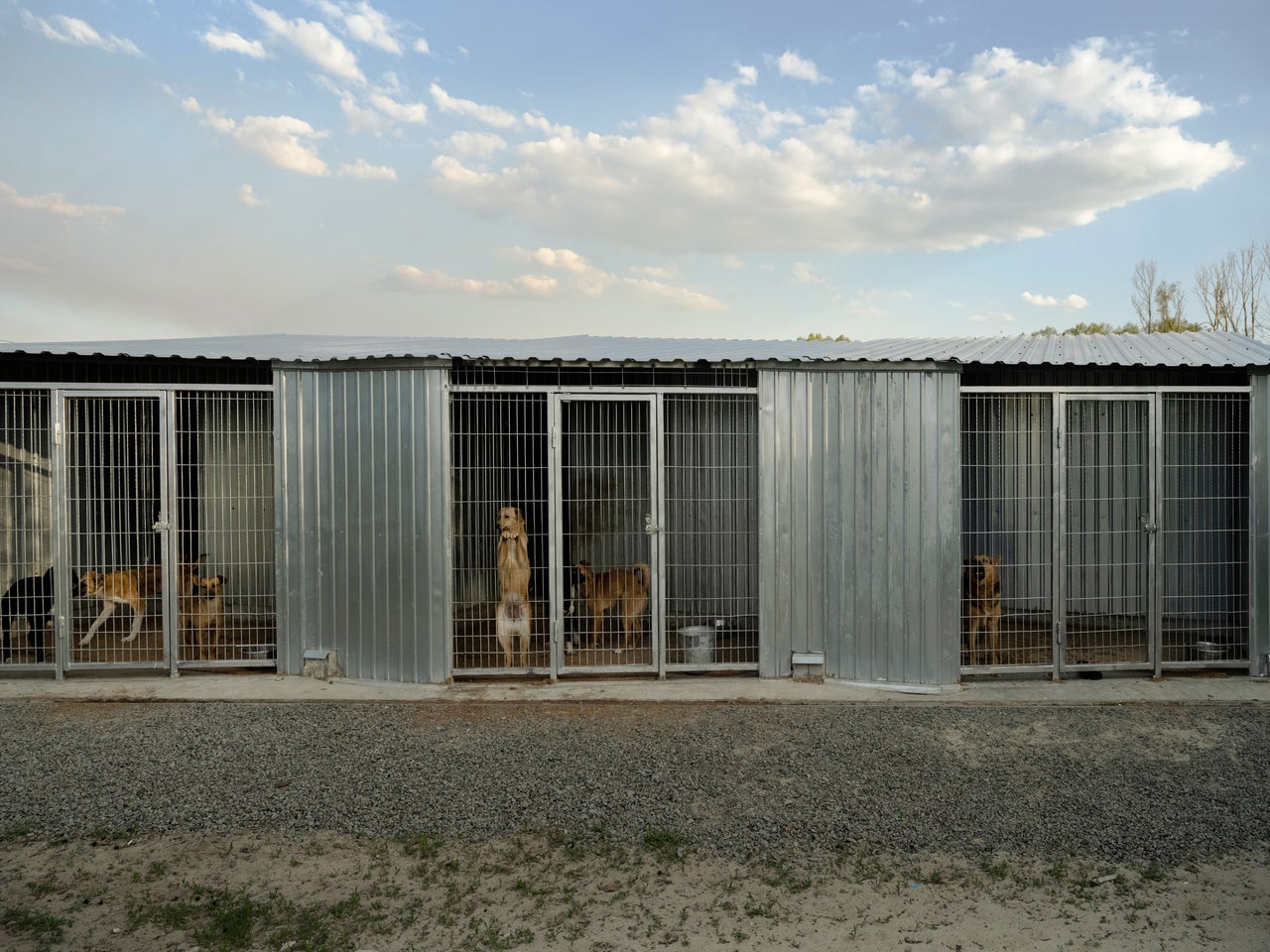
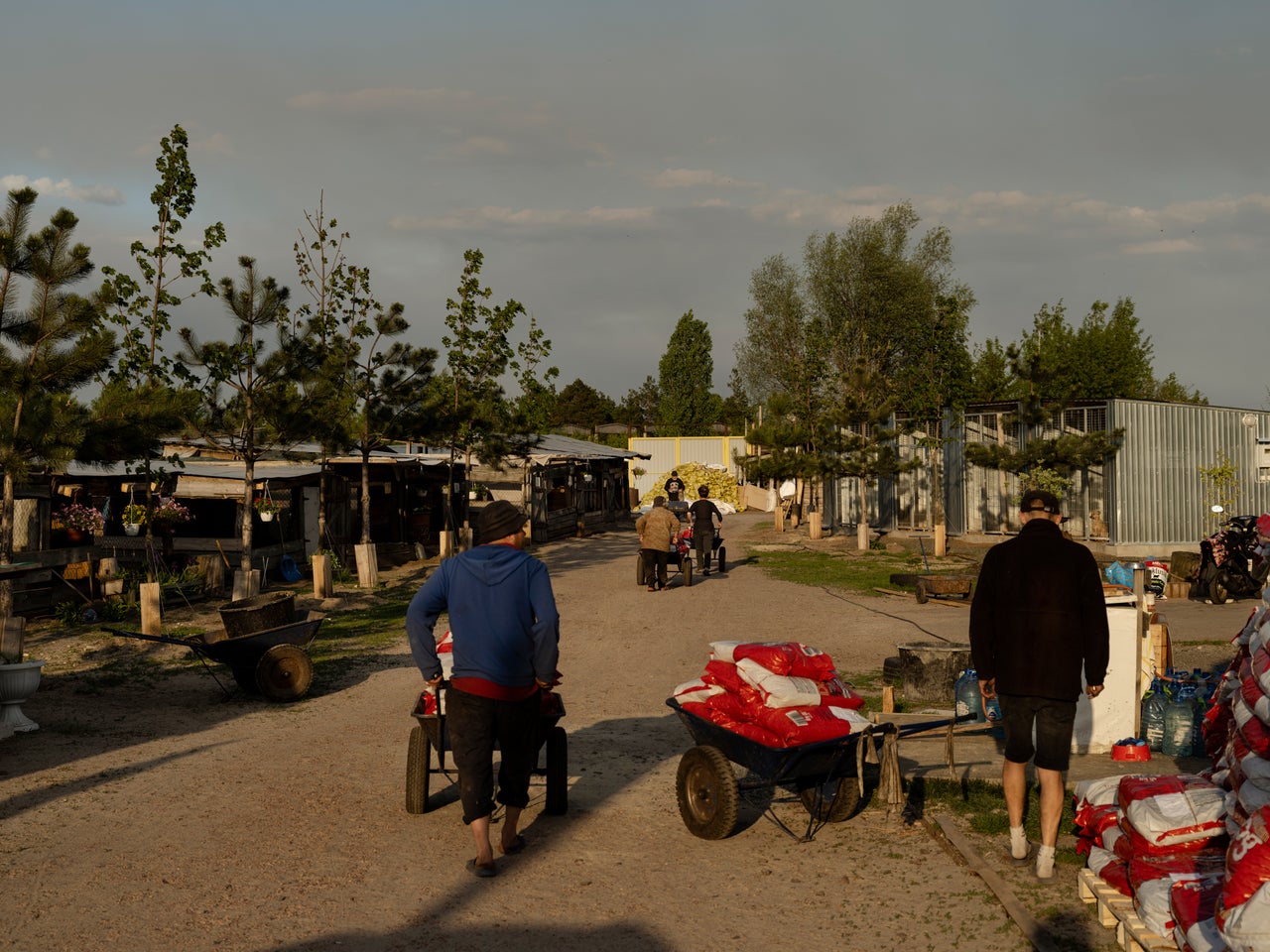
A dachshund named Trudy who was in Shumeiko’s care during the occupation was the first to travel to Germany this way. Immediately after Ivankiv was back under Ukrainian control, Shumeiko headed to Kyiv with the injured dog in a crate, making the first leg of the journey to Trudy’s new family in Germany. After a seven-hour trip to the capital, which usually takes about an hour, Shumeiko put her first adoptee on a bus, accompanied by a volunteer who was taking several dogs across the border to their new homes.
Since then, 11 dogs that went through Shumeiko’s shelter have been welcomed into new homes across Europe. It’s a monumental task to deliver each of them to their new owners, but for the volunteers, each time means another life was saved.
The process of bringing an animal across the western border of Ukraine can be tricky. During the first weeks of the war, amid the mass exodus, papers for animals being brought into the EU weren’t required. By the summer, the situation had changed and it became increasingly difficult to bring more than one or two pets over without supporting documents.
For volunteers and organizations trucking rescue animals to European shelters or directly to new owners, it became a problem. They weren’t let across the land border with Poland and had to return to Ukraine. There were reported incidents of people in distress releasing scared animals into the fields near the Polish border. These organizations started withdrawing from the Poland-Ukraine border, partly because it became impossible to do their work and partly because interest in adopting a pet from Ukraine started fading.
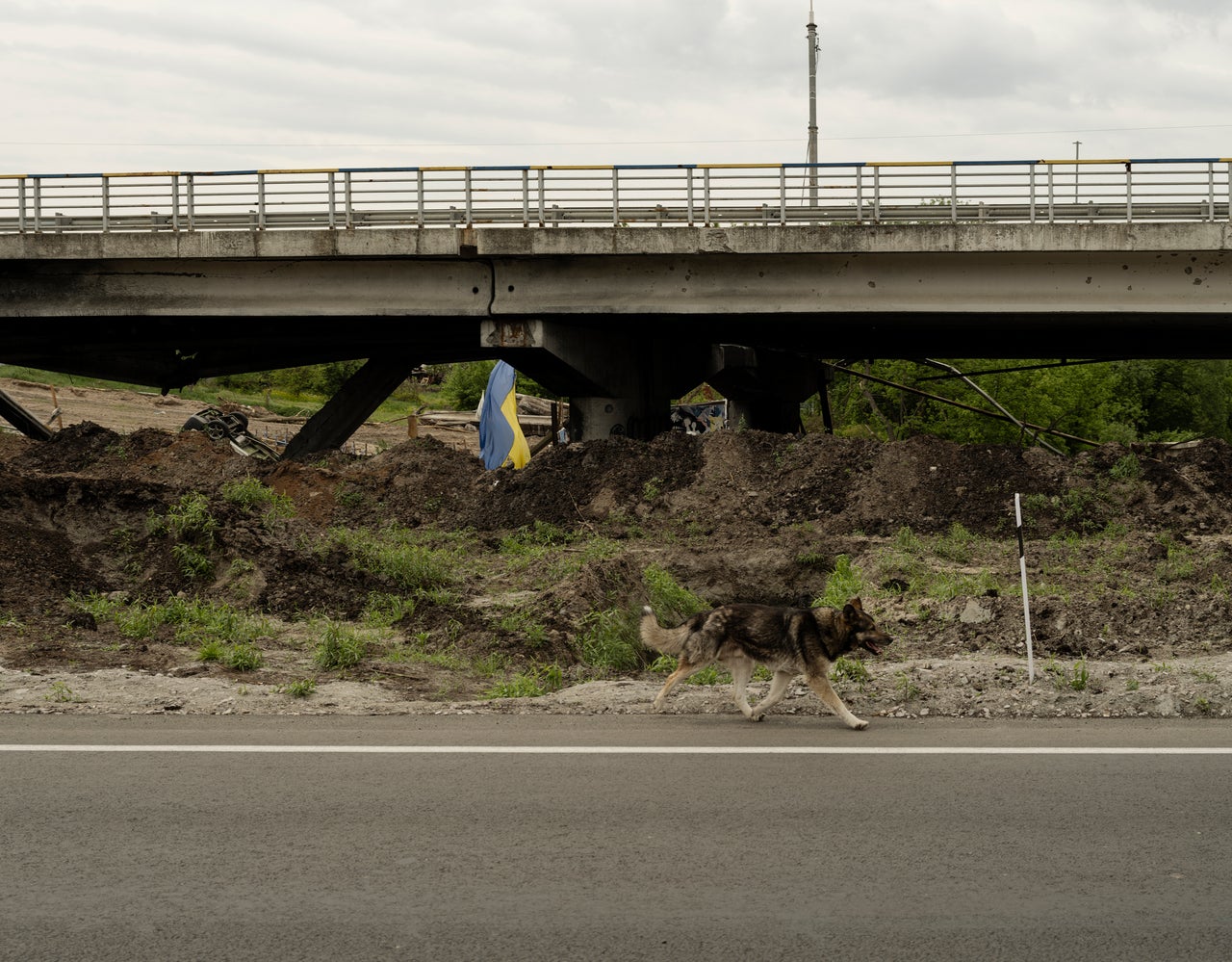
“Now all shelters in Europe are overwhelmed with Ukrainian rescue animals”, said Victoria Shaulska, a volunteer with the German nonprofit Save A Life Today. Shaulska had been working on finding new homes for rescue pets from Ukraine long before the war and saw the jump in enthusiasm and then a gradual decline during the war.
Over the past eight years, Save A Life Today has found homes for around 7,600 dogs and cats in Germany, but the war changed everything. First, there was an explosion of desire to house pets from Ukraine, then a gradual decline.
“Pragmatic Germans are now worried to take on an additional member of the family,” Shaulska said.
Cynthia van de Kamp, 24, has felt this declining interest as well. She and her husband, Vadim, have become accidental animal activists during the war. They moved to Ukraine two months before the full-scale invasion, and a couple of weeks into the war, they found it impossible to focus on their work. Both of them were working remotely for a call center in Poland and took time off to find a cause for which they could be useful.
Scanning the Telegram channels of volunteer organizations, they saw an unaddressed request for help with animals. Before the war, van de Kamp and her husband had two rescues and had just taken in a third — a pitbull named Dio who arrived from Turkey, where he was facing a bleak future as a banned breed. Dio arrived at Kyiv Boryspil airport a few hours before the airspace was closed for civil aviation, as the first Russian missiles were on the way to their Ukrainian targets. The big war has started, and they wanted to help.

Van de Kamp found her schedule full of tasks at one particular shelter, SOS Kyiv, finding and delivering cat food, picking up runaway dogs or saving abandoned pet rats from occupied Bucha. On top of that, they were delivering food and humanitarian aid to people in need. “Anything we could do, we did,” she recalled of the first weeks of volunteering.
By summer, their little group had grown to six people and had picked up some steam. They chose the name Van De Kamp Group, made a website, and opened some social media channels for fundraising. The scope of their work expanded, and they delivered food and medicine to recently liberated territories and helped the military with supplies — all while still rescuing animals. Their expenses also grew. In June and July, Van de Kamp also started seeing a decline in foreign enthusiasm.
“I guess it became boring for the people outside of Ukraine,” she said, having noticed that YouTube videos and Instagram posts asking for help were not getting as much attention as before. “Less and less people were watching videos, less and less people were donating.”
With the war continuing to be a very grim reality, larger organizations and nonprofits have developed some mechanisms to aid animals. Most large international organizations have representation in Ukraine and help local shelters and animal rescue efforts. However, the main goal for Ukrainian shelters is to find homes for animals suffering because of the war.
“I want to find them as many European and foreign families as possible,” said Oleksandra Mezinova, 53, a Ukrainian animal rights activist and the founder of Sirius, the largest animal shelter in Ukraine, which hosts about bout 3,200 dogs and more than 300 cats, as well as two chickens and a hedgehog named Eugenia. “We have a war going on, and our lives, as well as our animals’ lives, are uncertain.”
Mezinova founded Sirius on a farm she rented in 1999. She was running it out of her own pocket for about three years before the first donations started coming in. Now, the shelter gets by on a combination of her team’s enthusiasm and donations, as well as grants and organizational support.
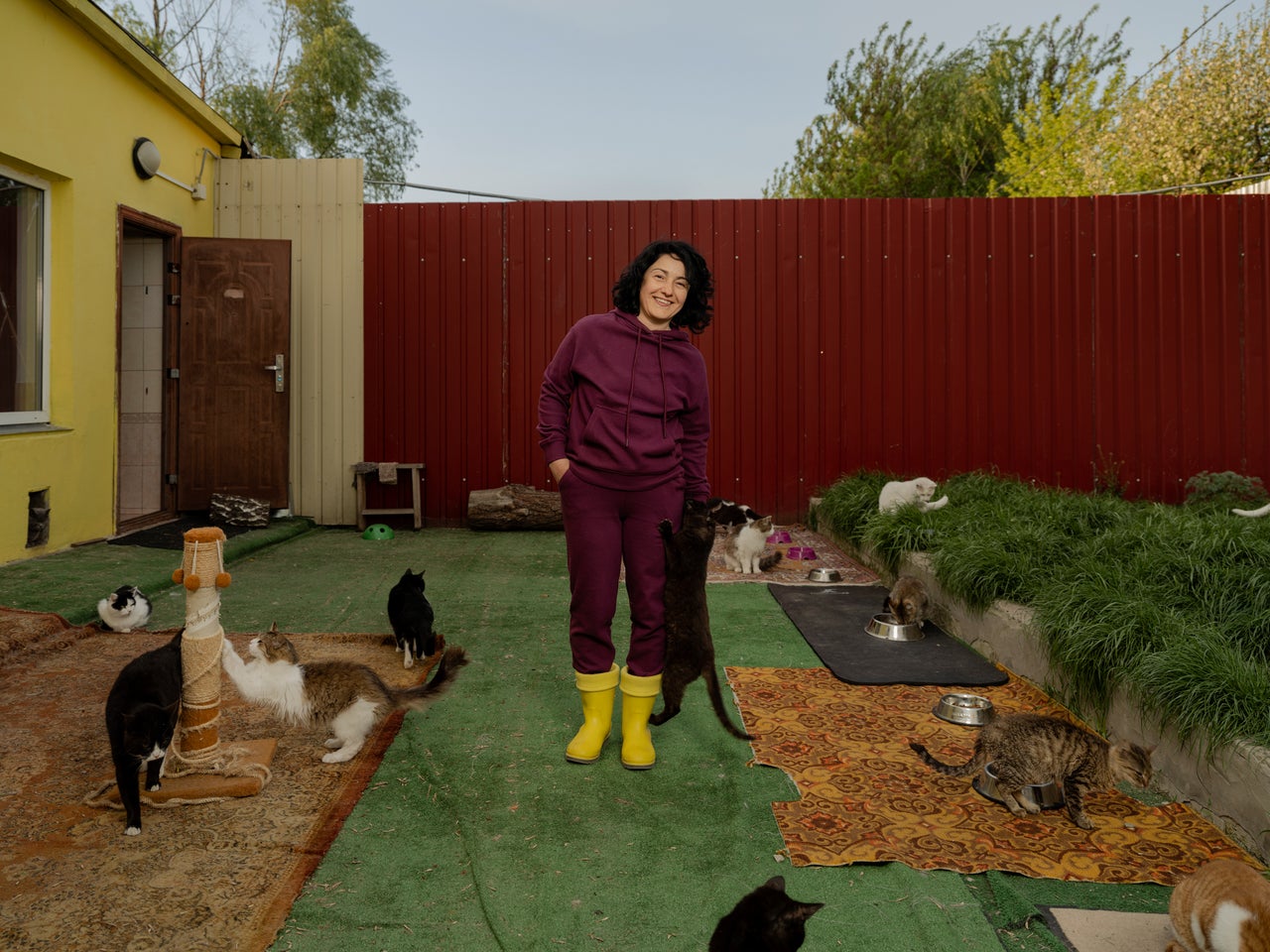
Fedorivka, where Sirius shelter is located, was occupied early in the war. Facing the terrifying prospect of hundreds of animals starving to death, Mezinova took it upon herself to go to the Russian soldiers and convince them to grant her permission to drive around nearby villages looking for food from local farms.
This gave her a bit more freedom under the occupation, but the risks were still great. “Every time I was heading out, I’d leave the instructions to the staff what to do if I don’t return,” Mezinova recalled. She came to terms with the fact that she could be killed on the road by the occupying Russian forces, like so many other civilians.
Once, it nearly came to that. On March 22, while traveling in her minivan with two co-workers, Mezinova was stopped at a checkpoint by Russian soldiers who accused them of spying for the Ukrainians. Shelling erupted during the interrogations. Seeking cover with the Russian soldiers, they were first led into a nearby warehouse and then thrown into a basement. There, the three of them sat holding hands, confident that this was the last day of their lives.
“And you know what’s funny? We were asking each other what each of us was thinking about, and every one of us said: that the dogs will go hungry.” Eventually, Mezinova and her colleagues were released.
At the shelter, cut off from the world — no electricity, water or internet — Mezinova found a way to communicate through a hidden cell phone. Typing up text messages throughout the day and saving them on her phone, she would walk over to a spot on a hill nearby where she could find a signal and send the messages out.
Mezinova’s assistant in Kyiv would receive the messages and resend them to a wide network of animal rights organizations and political parties across Europe, which started a campaign to help her shelter.
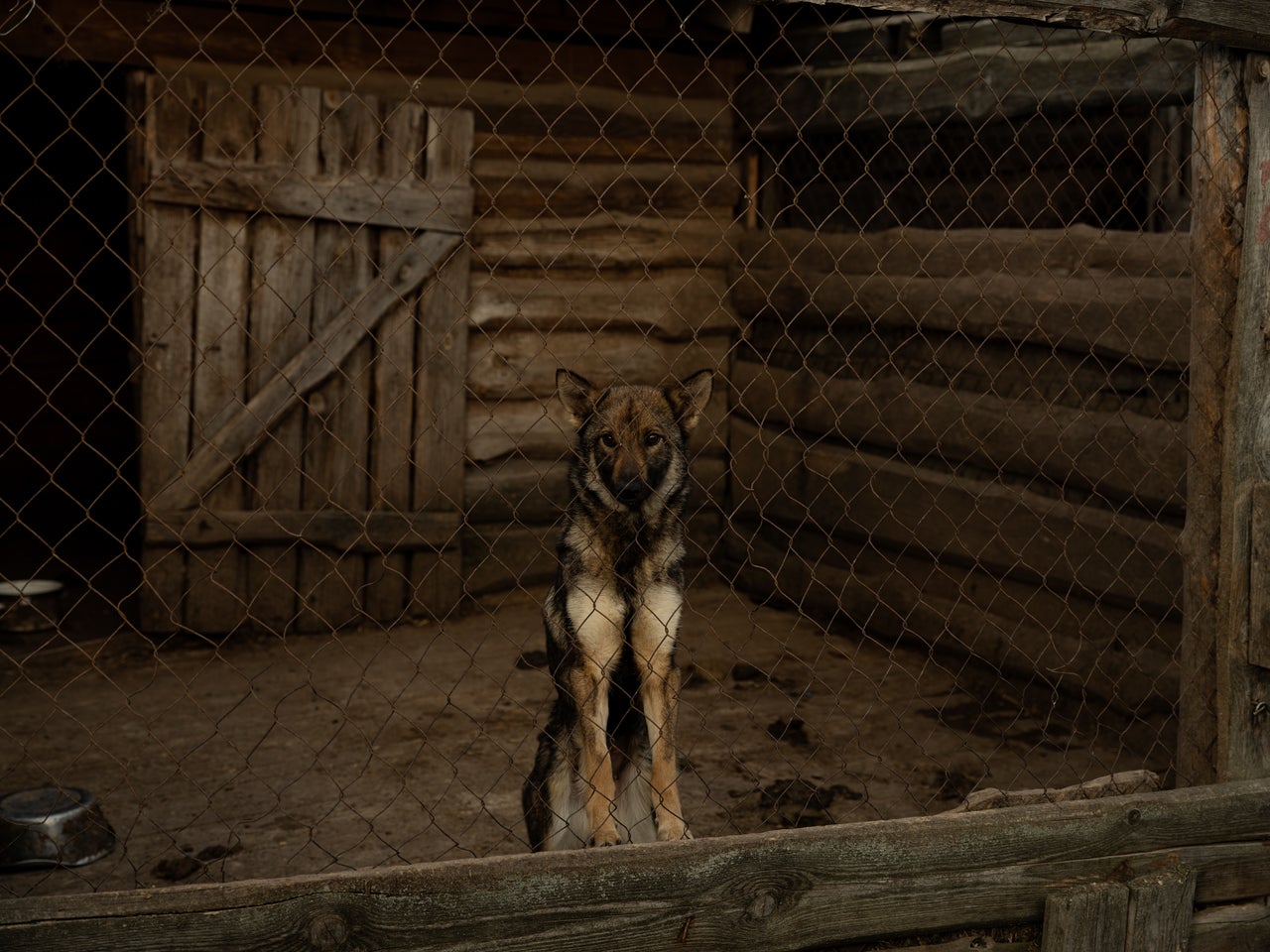
This activity could have cost Mezinova her life, especially because she wasn’t only passing on information about the needs of the shelter, but was also sharing intelligence on Russian movements in the area.
As a result of her activism and cries for help, a stream of volunteers working for animal organizations from all over Europe started making their way to Sirius immediately after the region was liberated by the Ukrainian Army at the beginning of April. There was help coming to feed the animals and to find them new homes in Ukraine or elsewhere in Europe. If the percentage of Ukrainian pets adopted by people outside of Ukraine was only about 10{95b18eb6fc4f42efd0d92738dfc3fb79fde21da267a711ecdf0381147c27bb86} before the war, by mid-summer, it reached 70{95b18eb6fc4f42efd0d92738dfc3fb79fde21da267a711ecdf0381147c27bb86}.
Though enthusiasm for Ukrainian animals started dwindling at the end of the summer, the number of animals coming to Sirius’ doors hasn’t let up. “We don’t say no,” Mezinova exclaimed. Every time Ukraine liberates a part of its territory, the shelter expects a new stream of animals. The last wave came from the Kherson area in November. Sirius is well-known by the military and volunteers, and many think of it first when it comes to finding an animal shelter.
And even though Sirius, as well as most shelters in Ukraine, are way over capacity, Mezinova is looking forward to tomorrow. “I hope we’ll finish the cat house soon, contrary to Putin’s plans,” she said laughing, standing in the middle of the half-built structure among dozens of cats who are waiting for their new homes in Ukraine, Europe or elsewhere.








